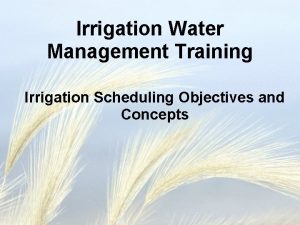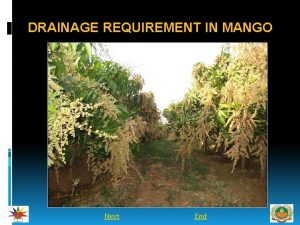IRRIGATION SCHEDULING AND TECHINIQUES IN MANGO Next End










- Slides: 10

IRRIGATION SCHEDULING AND TECHINIQUES IN MANGO Next End

INTRODUCTION • Amount and frequency of irrigation depends upon the type of soil, prevailing climatic conditions, especially the rainfall and its distribution, temperature, relative humidity and age of trees. • Irrigation is not required during the monsoon months unless there are long spells of drought. • Generally, the young plants with shallow root system need regular frequent irrigation during dry period. Previous Next End

CONT. . • However bearing trees develop deep, well spread, extensive root system and do not usually require watering except during fruit development period, beginning from fruit set stage to full development stage, when irrigation should be given at an interval of 10 15 days, depending on soil and climatic condition. • This results in increased fruit set, decreased fruit drop and improvement in fruit size and fruit quality. Irrigation is not required during the monsoon months unless there are long spells of drought. Irrigation must be stopped at least 2 – 3 months before the flowering period. Irrigation during this period usually promotes vegetative growth and adversely affects flowering. Previous Next End

IRRIGATION • Mango needs 125 to 170 cm of precipitation annually; but on account of deep tap root system, it requires little irrigation after the first few years. • When the planting is done in spring, the young plants require irrigation fourth or fifth day during the first summer till the rains break. • During rains, irrigation should be given only if the soil dries up. • The bearing plants are often given no irrigation but irrigation during flowering reduces fruits. • Irrigation if withheld during the pre flowering phase increases flowering, otherwise, irrigation during this period is likely to promote vegetative growth. • Trees receiving heading back pruning needs to be provided 2 3 irrigation at that time to induce new shoot formation. Previous Next End

IRRIGATION FREQUENCY • During the first year, when the plants are very young with shallow root system, they should be watered at 2 3 days interval in the dry season. Trees in the age group of 2 5 years should be irrigated at 4 5 days interval. • The irrigation interval could be increased to 10 15 days for 5 8 years old plants during dry season. • When the trees are in full bearing stage 2 3 irrigations are given after fruit set. • Frequent irrigation during flowering is not advisable as it induces more vegetative growth and thereby affects flowering Previous Next End

• Irrigation should be given at 50 per cent field capacity. • Generally, inter crops are grown during the early days of plantation and hence, frequency and method of irrigation has to be adjusted accordingly. • Basin type of irrigation is followed in mango. • In rainfed mango, water conserving strategies must be adopted to save moisture in the soil to obtain reasonable production. • The farm ponds and use of mulches help to increase the soil moisture conservation. Previous Next End

CONT. . • Generally intercrops are grown during the early years after plantation and hence method of application has to be adjusted accordingly. • Up to 5 years after planting, it is better to make basins around the plants and connect them in series so that irrigation could be administered independent of the intercrop. • For subsequent age, irrigation can be combined with that of intercrops. • However, if intercrops are to be abandoned in fully bearing orchards then basin system should be followed so as to economise on the water use. Then the basins may be connected in series or to a channel dug in between the rows. Previous Next End

DRIP IRRIGATION • In recent years, acute water scarcity in several parts of the country coupled with dwindling water resources have lead to switch over to drip irrigation, an alternative, efficient and water saving system. • Drip irrigation system has become more popular and adapted by many growers. • Apart from economy in water use, there will be labour saving and also the possibility of using soluble nutrients through the drip system called ‘fertigation’ resulting in increased fertilizer and water use efficiency. Previous Next End

The drip irrigation schedule is based on evapo transpiration rates Sl. No. Age of plant (yr) Quantity of water (l/plant) Emitters/plant 1. 2 2 5 1 at 15 cm away from plant 2. 2 4 10 25 2 at 45 cm away from plant 3. 5 10 30 90 4 at 45 cm away from plant Previous Next End

FERTIGATION • By following fertigation method, the quantity of fertilizer could be reduced by 20 to 25 per cent, when applied through drip irrigation. • In one of the fertilizer trials, the recommended doses of fertilizers in fertigation of mango are as follows: S. No Stages Percentage of nutrients required N (%) P (%) K (%) Time of application 1. Vegetative 60 70 40 Weekly interval 2. Reproducti ve 40 30 60 Weekly interval Previous Next End



















